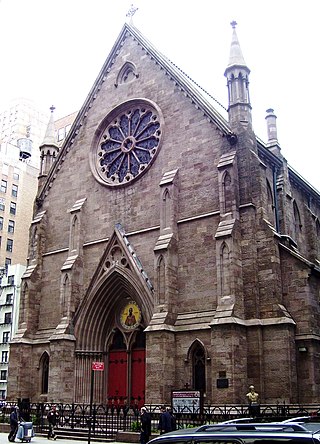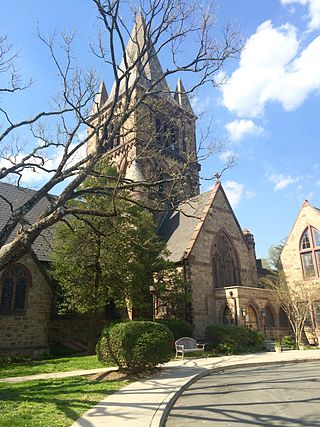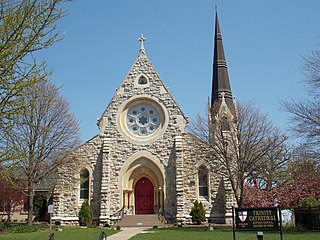Trinity Church is a historic parish in the Episcopal Diocese of New York, whose church is located at 89 Broadway opposite Wall Street, in the Financial District of Lower Manhattan in New York City. Known for its centuries of history, prominent location, distinguished architecture and bountiful endowment, Trinity's congregation is said to be "high church", its activities based on the traditions of the Episcopal Church and the worldwide Anglican Communion in missionary outreach, and fellowship. In addition to its main church, Trinity parish maintains two chapels: St. Paul's Chapel, and the Chapel of St. Cornelius the Centurion on Governors Island. The Church of the Intercession, the Trinity Chapel Complex and many other of Manhattan's Anglican congregations were once part of Trinity parish. Columbia University was founded on the church's grounds as King's College in 1754. To some, the congregation epitomizes White Anglo-Saxon Protestant culture in the United States.

The Smithsonian Institution Building, more commonly known as the Smithsonian Castle or simply The Castle, is a building on the National Mall housing the Smithsonian Institution's administrative offices and information center. Built as the first Smithsonian museum building, it is constructed of Seneca red sandstone in the Norman Revival style. It was completed in 1855 and designated a National Historic Landmark in 1965.

The Church of the Intercession is an Episcopal congregation located at 550 West 155th Street, at Broadway, on the border of the Harlem and Washington Heights neighborhoods of Manhattan, New York City, on the grounds of Trinity Church Cemetery. The congregation was founded in 1846, and the current sanctuary, built in 1912–1915, was designed by Bertram Grosvenor Goodhue in the Gothic Revival style. From 1906–1976, it was a chapel of Trinity Church.

James Renwick Jr. was an American architect in the 19th century, noted especially for designing churches and museums. The Encyclopedia of American Architecture calls him "one of the most successful American architects of his time".

William Wilson Corcoran was an American banker, philanthropist, and art collector. He founded the Corcoran Gallery of Art.

Grace Church is a historic parish church in Manhattan, New York City which is part of the Episcopal Diocese of New York. The church is located at 800–804 Broadway, at the corner of East 10th Street, where Broadway bends to the south-southeast, bringing it in alignment with the avenues in Manhattan's grid. Grace Church School and the church houses—which are now used by the school—are located to the east at 86–98 Fourth Avenue between East 10th and 12th Streets. In 2021, it reported 1,038 members, average attendance of 212, and $1,034,712 in plate and pledge income.

The Church of the Ascension and Saint Agnes is an Episcopal church building located at 1215 Massachusetts Avenue in Northwest Washington, D.C., US. The current structure built in 1874 as the Church of the Ascension was added to the National Register of Historic Places in 1984. In the late 1940s, the Church of the Ascension merged with the nearby St. Agnes Episcopal Church and adopted its present name, under which it has continued as an active parish in the Episcopal Diocese of Washington.

St. Paul's Episcopal Church is located at North Hamilton and Mansion streets on the west side of Mansion Square in Poughkeepsie, New York, United States. It is a stone church in the Norman-Gothic Revival styles built in the late 19th century.

St. Mary's Episcopal Church, also known as St. Mary's, Foggy Bottom or St. Mary's Chapel, is a historic Episcopal church located at 730 23rd Street, N.W. in the Foggy Bottom neighborhood of Washington, D.C. On April 2, 1973, St. Mary's Episcopal Church was added to the National Register of Historic Places.

Trinity Episcopal Church is an historic Episcopal church building at 88 Walker Street in Lenox, Massachusetts. Built in 1888 for a congregation organized in 1793, it is a prominent local example of Romanesque architecture, funded by Gilded Age summer congregants. The church was listed on the National Register of Historic Places in 1996.

The Church of St. Barnabas is an Episcopal house of worship in Irvington, New York, United States. It is a stone Gothic Revival structure whose oldest sections date to the mid-19th century, with several expansions undertaken since then. The reputedly haunted church complex was added to the National Register of Historic Places in 2000.

The Oak Hill Cemetery Chapel, also known as the Renwick Chapel or James Renwick Chapel, is a historic building in the Georgetown neighborhood of Washington, D.C., United States. Designed by James Renwick, Jr. in 1850, Oak Hill Cemetery Chapel is the architect's only known example of Gothic Revival church architecture in Washington, D.C. It is located on the highest ridge in Oak Hill Cemetery, near the intersection of 29th and R Streets NW. The chapel is one of two structures in Oak Hill Cemetery listed on the National Register of Historic Places, the other being the Van Ness Mausoleum. The chapel, mausoleum, and cemetery are contributing properties to the Georgetown Historic District, a National Historic Landmark.

Holy Trinity Episcopal Church also known as Holy Trinity Memorial Church is an historic Episcopal church building located at 38 Grand Avenue in the village of Swanton, Franklin County, Vermont. Built in 1876 and expanded in 1909-10, the church facilities include a fine example of the Carpenter Gothic in the older section, and the Late Victorian Gothic Revival in the newer section. The church was listed on the National Register of Historic Places as the Parish of the Holy Trinity in 2001. The church is an active parish in the Episcopal Diocese of Vermont; its current rector is the Rev. Reid D. Farrell.

The Trinity Chapel Complex, now better known as the Serbian Orthodox Cathedral of St. Sava is a historic Eastern Orthodox church at 15 West 25th Street between Broadway and the Avenue of the Americas in the NoMad neighborhood of Manhattan, New York City.

Trinity Parish Church is a historic church located in the First Hill neighborhood of Seattle, Washington, that was added to the National Register of Historic Places in 1991. It is an Episcopal congregation in the Diocese of Olympia.

Trinity Church is a historic Episcopal congregation located at 33 Mercer Street in Princeton, New Jersey. It is the largest Episcopal church in New Jersey.

Trinity Episcopal Cathedral, formerly known as Grace Cathedral, is the historic cathedral in the Diocese of Iowa. The cathedral is located on the bluff overlooking Downtown Davenport, Iowa, United States. Completed in 1873, Trinity is one of the oldest cathedrals in the Episcopal Church in the United States. It was individually listed on the National Register of Historic Places in 1974. In 1983 the cathedral was included as a contributing property in the College Square Historic District, which is also listed on the National Register.

Calvary Church is an Episcopal church located at 277 Park Avenue South on the corner of East 21st Street in the Gramercy Park neighborhood of Manhattan, New York City, on the border of the Flatiron District. It was designed by James Renwick Jr., the architect who designed St. Patrick's Cathedral and Grace Church, and was completed in 1848. The church complex is located within the Gramercy Park Historic District and Extension. It is one of the two sanctuaries of the Calvary-St. George's Parish.

Trinity-St. James United Methodist Church is located in Cedar Rapids, Iowa, United States. The congregation began as a Sunday school in the northwest part of the city organized by Trinity Methodist Episcopal Church. The evangelist Billy Sunday had preached a revival there and over 300 people joined the church. St. James Methodist Episcopal Church, as it was then known, was established shortly afterward in February 1910. The congregation originally used the closed Danish Lutheran Church at K Avenue NW and Fourth Street NW for their services, and they moved the building that summer to Ellis Boulevard NW. St. James grew to the point that a new building was needed. In 1945 property across the street was purchased, and local architect William J. Brown designed the new church facility. Construction began in September 1952 and it was completed in April 1954 for $165,000.





















